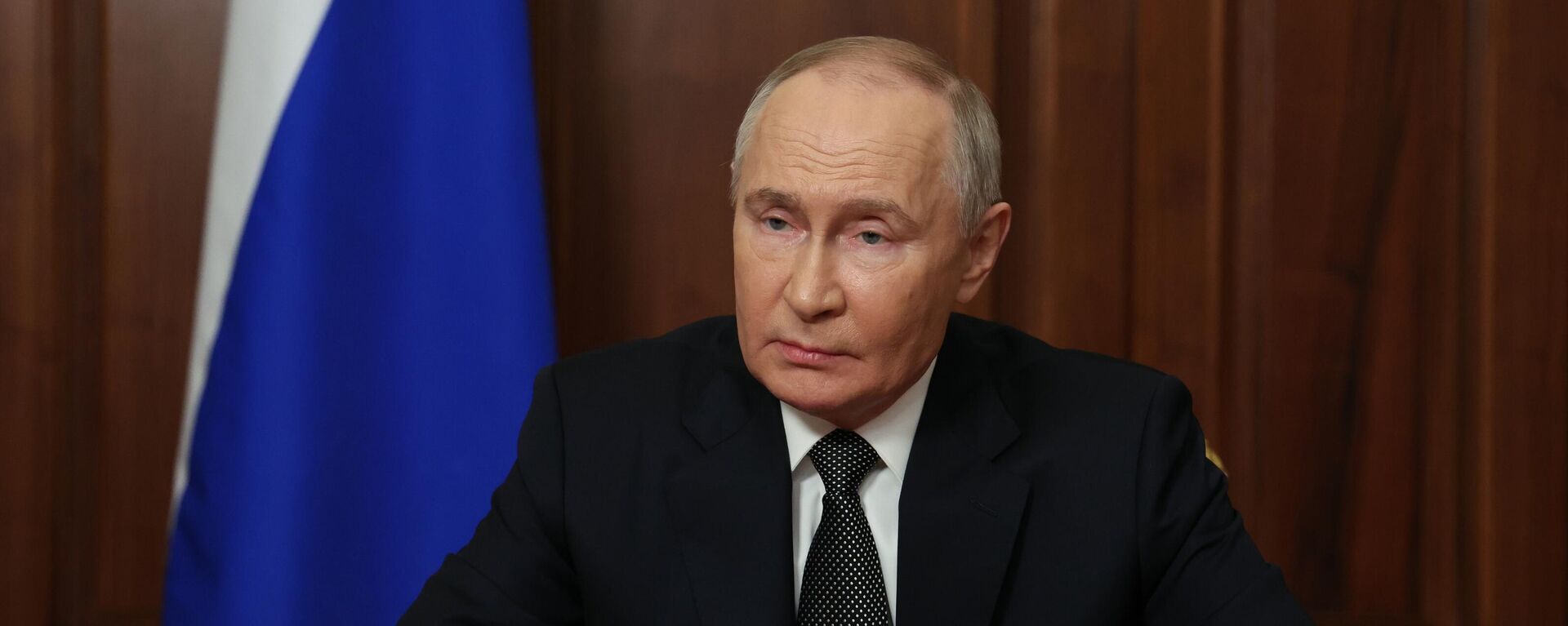https://sputniknews.in/20241129/indian-military-would-be-keen-to-acquire-oreshnik-like-missile-ex-gr-captain-8471608.html
Indian Military Would Be Keen to Acquire Oreshnik-Like Missile: Ex-Gr Captain
Indian Military Would Be Keen to Acquire Oreshnik-Like Missile: Ex-Gr Captain
Sputnik India
The Oreshnik made its warzone debut in the Ukrainian theatre last week, which was in response to the use of Western-made long-range missiles against Russian... 29.11.2024, Sputnik India
2024-11-29T18:53+0530
2024-11-29T18:53+0530
2024-12-30T15:30+0530
sputnik opinion
indian air force (iaf)
indian space research organisation (isro)
ukraine
russia
india
volodymyr zelensky
vladimir putin
drdo
missiles
https://cdn1.img.sputniknews.in/img/07e8/0b/1d/8472003_0:0:1280:720_1920x0_80_0_0_d4aac050ca98593e549b6f9b3f19d7d3.png
The Indian military would be "keen" to acquire a weapon like Russia's Oreshnik missile considering there's no air defence system on Earth at present that can track and destroy it.Russia had launched the Oreshnik missile on the Ukrainian city of Dnepropetrovsk, which inflicted heavy damage to the local military facility. Later on, President Vladimir Putin confirmed it was a brand new Russian weapon.After Oreshnik is fired, it releases six warheads in its terminal phase but what makes this missile stand out from other weapons is its extraordinary speed of Mach 10, which is more than 10 times the speed of sound, Devnath highlighted. It would be impossible for any air defence system in the world to intercept this missile traveling at such an incredible speed, Devnath noted. Oreshnik is not just a hypersonic missile: it is an upper-end hypersonic missile untraceable by the existing air defence platforms on the planet.The Indian military establishment would have taken note of the Oreshnik as New Delhi has been closely watching the moves of both Russia and Ukraine/NATO in the warzone, Devnath opined. For the unversed, the following day, India's strategic command held a meeting at South Block and exchanged their views on Russia's new weapon.He further elaborated that this could be achieved either through indigenous development as the Defence Research and Development Organisation (DRDO) and Indian Space Research Organisation (ISRO) are very much capable of developing a missile similar to Oreshnik or under a joint venture with Russia.Air Marshal (Retd) M. Matheswaran observed that Oreshnik was a hypersonic missile and interestingly, India tested its own hypersonic missile just a few days ago. Oreshnik weapon is also a multiple independently targetable reentry vehicle (MIRV), the same capability India acquired recently.One must understand that Oreshnik was fired by Russia because there were major escalatory developments in the Ukraine sphere because of the US authorising the use of Western long-range missiles deep inside Russian territory. So, it is a warning to deter them from further escalating this conflict, he remarked.For India, that kind of threat is not there at the moment. Hence, the country's own research and development process will be focused on gaining such capability or developing a missile such as Oreshnik on its own, Matheswaran elucidated.According to Air Marshal (Retd) Anil Khosla, Oreshnik's ability to carry multiple homing warheads and reach extreme temperatures of 4,000°C presents a significant threat to conventional missile defence systems.He believes that India's military establishment would likely view Russia's Oreshnik missile with a strategic interest and may closely study the technology behind Oreshnik’s hypersonic speed, multi-warhead capabilities, and extreme heat resistance.This could also impact India's strategic partnerships and technology acquisition efforts, particularly bolstering its Ballistic Missile Defence and hypersonic deterrence programs, he concluded.
https://sputniknews.in/20241129/strikes-on-ukraine-defense-facilities-was-russias-response-to-us-missile-strikes-kremlin-8469950.html
ukraine
russia
india
us
Sputnik India
feedback.hindi@sputniknews.com
+74956456601
MIA „Rossiya Segodnya“
2024
Pawan Atri
https://cdn1.img.sputniknews.in/img/07e6/0c/13/139630_147:0:831:684_100x100_80_0_0_8fa2b25903e7787fe6a2698552c167df.png
Pawan Atri
https://cdn1.img.sputniknews.in/img/07e6/0c/13/139630_147:0:831:684_100x100_80_0_0_8fa2b25903e7787fe6a2698552c167df.png
News
en_IN
Sputnik India
feedback.hindi@sputniknews.com
+74956456601
MIA „Rossiya Segodnya“
Sputnik India
feedback.hindi@sputniknews.com
+74956456601
MIA „Rossiya Segodnya“
Pawan Atri
https://cdn1.img.sputniknews.in/img/07e6/0c/13/139630_147:0:831:684_100x100_80_0_0_8fa2b25903e7787fe6a2698552c167df.png
indian air force (iaf), indian space research organisation (isro) , ukraine, russia, india, volodymyr zelensky, vladimir putin, drdo, missiles, us, nato, special military operation, russian armed forces, ukraine armed forces, oreshnik ballistic missile
indian air force (iaf), indian space research organisation (isro) , ukraine, russia, india, volodymyr zelensky, vladimir putin, drdo, missiles, us, nato, special military operation, russian armed forces, ukraine armed forces, oreshnik ballistic missile
Indian Military Would Be Keen to Acquire Oreshnik-Like Missile: Ex-Gr Captain
18:53 29.11.2024 (Updated: 15:30 30.12.2024) The Oreshnik made its warzone debut in the Ukrainian theatre last week, which was in response to the use of Western-made long-range missiles against Russian territory.
The Indian military would be "keen" to acquire a weapon like
Russia's Oreshnik missile considering there's no air defence system on Earth at present that can track and destroy it.
Russia had launched the Oreshnik missile on the Ukrainian city of Dnepropetrovsk, which inflicted heavy damage to the local military facility. Later on, President Vladimir Putin confirmed it was a
brand new Russian weapon.
"It hit six targets in Dnepropetrovsk's military-industrial complex. While visibly it looked like a strike by a nuclear warhead, however, as no radiation was found on the site of destruction, it eventually confirmed that Russia fired a conventional intermediate-range ballistic missile (IRBM) at Zelensky's forces," Group Captain (Retd) Uttam Kumar Devnath has told Sputnik India.
After Oreshnik is fired, it releases six warheads in its terminal phase but what makes this missile stand out from other weapons is its extraordinary speed of Mach 10, which is more than 10 times the speed of sound, Devnath highlighted.
It would be impossible for any air defence system in the world to intercept this missile traveling at such an incredible speed, Devnath noted. Oreshnik is not just a hypersonic missile: it is an upper-end hypersonic missile untraceable by the existing air defence platforms on the planet.
If we talk about Ukraine's air defences specifically, they are simply not capable of dealing with such a missile, Devnath underscored.
The Indian military establishment would have taken note of the Oreshnik as New Delhi has been closely watching the moves of both Russia and Ukraine/NATO in the warzone, Devnath opined. For the unversed, the following day, India's strategic command held a meeting at South Block and exchanged their views on Russia's new weapon.
"Given the damage Oreshnik can cause on the battlefield and the 'impossible' factor associated with its traceability, the Indian Armed Forces would definitely be keen to acquire such a weapon system in the near future," Devnath assumed.
He further elaborated that this could be achieved either through indigenous development as the Defence Research and Development Organisation (DRDO) and Indian Space Research Organisation (ISRO) are very much capable of developing a missile similar to Oreshnik or under a joint venture with Russia. "In the past, Russia has readily transferred critical defence technology to India, and even in Oreshnik's case, it should be no different," he summed up.
Air Marshal (Retd) M. Matheswaran observed that Oreshnik was a hypersonic missile and interestingly, India tested its own hypersonic missile just a few days ago.
Oreshnik weapon is also a multiple independently targetable reentry vehicle (MIRV), the same capability India acquired recently.
"This kind of capability is necessary for deterrence. It gives much more flexibility to the IAF in deterring the adversary. As far as India is concerned, this is an area where research is an ongoing process," Matheswaran said in a conversation with Sputnik India.
One must understand that Oreshnik was fired by Russia because there were major escalatory developments in the Ukraine sphere because of the US authorising the use of
Western long-range missiles deep inside Russian territory. So, it is a
warning to deter them from further escalating this conflict, he remarked.
For India, that kind of threat is not there at the moment. Hence, the country's own research and development process will be focused on gaining such capability or developing a missile such as Oreshnik on its own, Matheswaran elucidated.
According to Air Marshal (Retd) Anil Khosla, Oreshnik's ability to carry multiple homing warheads and reach extreme temperatures of 4,000°C presents a significant threat to conventional missile defence systems.
He believes that India's military establishment would likely view Russia's Oreshnik missile with a strategic interest and may closely study the technology behind Oreshnik’s hypersonic speed, multi-warhead capabilities, and extreme heat resistance.
"India might assess this development in terms of its missile defence upgrades and hypersonic capabilities development programs. This could drive India to accelerate its hypersonic programs, such as the HSTDV (Hypersonic Technology Demonstrator Vehicle), and enhance its missile defence systems," Khosla, a former vice-chief of the IAF, told Sputnik India.
This could also impact India's strategic partnerships and technology acquisition efforts, particularly bolstering its Ballistic Missile Defence and hypersonic deterrence programs, he concluded.



